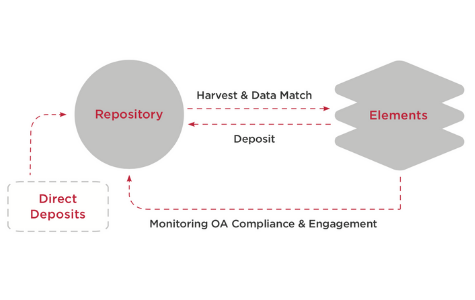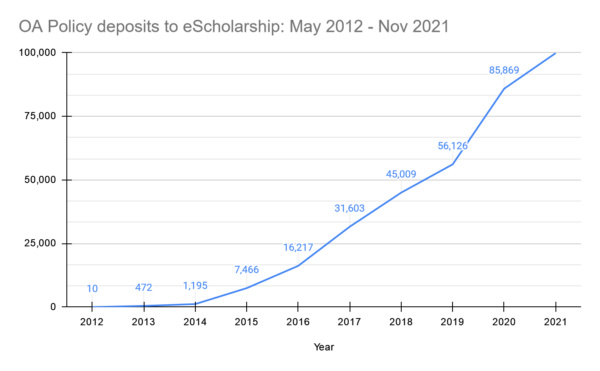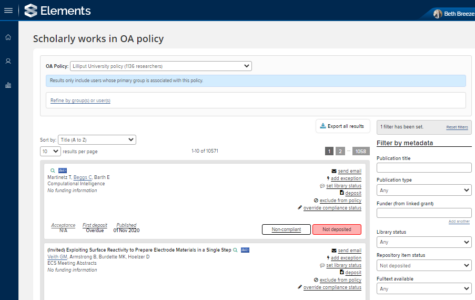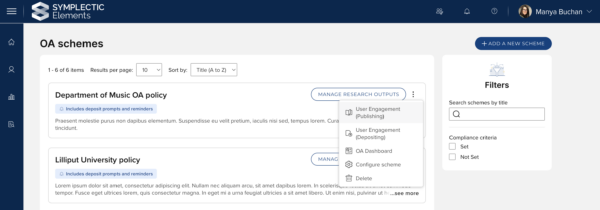At Symplectic, open data is part of our DNA. Symplectic Elements makes it easy to deposit publications and data into open repositories, ensuring compliance with both institutional and funder mandates.
We’ve always been ahead of the curve when it comes to open access and open data, and in this blog post, we’re taking a quick trip down memory lane to showcase some of the ways we’ve championed the OA movement.
In the 2000s….
In 2009, Symplectic Elements became the first commercially available research information management system to draw on data from multiple external sources to populate records and save academics time, and the first to be “open access aware” and connect to an institutional digital repository in order to enable open access deposit (at this time, DSpace; with the later additions of EPrints, Hyrax, and Figshare).
In 2012, Symplectic was an early innovator in ensuring that a Crossref version of each publication record was available to institutions, providing a CC0 version of article metadata that could be freely used by the institution, researchers, and their community as needed.
Symplectic has a long history of enabling data extraction and interoperability with third-party systems. Every data field in an institutions’ Elements instance is available to them for export either through the reporting database functionality or the API. Since Symplectic started working broadly with the global research community in 2008, this has been a core principle of how the system was designed and became a core part of work that it undertook as part of its implementation of support for the CERIF data standard more than 15 years ago.
Meanwhile, with Open Access becoming an increasingly important driver in both Europe and Australia, Symplectic expanded its ‘open access awareness’ beyond DSpace integration, introducing the ‘Repository Tools’ module in 2011 to enable integration with institutional repositories (including Figshare for Institutions, EPrints and Hyrax) in order to drive open access initiatives. Elements now had the ability to identify publications and outputs that were eligible for institutional or governmental open access policies and flag them for deposit, helping to guide researchers to take easy action at the push of a button. We also introduced functionality allowing administrators to act on behalf of researchers, giving multiple routes toward Open Access compliance.

The introduction of the OA Monitor within Elements in 2015 went a step further, letting institutions easily monitor and report on their researchers’ levels of engagement or compliance levels. Using the OA Monitor, administrators could now filter publications by parameters to review progress, record exceptions, and track library status.
Open Access Functionality
Symplectic Elements provides institutions with an advanced and intuitive platform to streamline the management of Open Access (OA) compliance, increase researcher engagement, and ensure publications meet institutional and funder OA policies.
|
Streamlined Deposit Process By allowing users to easily deposit publications into open repositories with the push of a button, Symplectic Elements significantly increases deposit rates while guiding researchers through compliance steps and guidance. |
|
Intelligent data harvesting and easy deposit Intelligent data harvesting means Elements is always working for you in the background, continuously identifying and matching research outputs to populate your publication record in Elements. As the metadata of scholarly works is already in Elements, deposit becomes as simple as a few mouse clicks. |
|
Custom Reporting and Data Insights Administrators can use the inbuilt OA Monitor to track, prompt, and report on this process, delivering a holistic view of OA compliance and engagement at an institutional level. Institutions can easily visualize progress toward compliance, record exceptions, and track user activity. |
|
Guidance and Support Clear call-outs on researchers’ homepages guide them toward depositing their work, guiding users to deposit their publications to selected institutional repositories directly. Deposit advice from Sherpa/RoMEO is embedded as standard, providing clarity over copyright. In addition, administrators can provide their own guidance at the organizational level or for particular publishers or journals. |
Open & Interoperable
Symplectic took another big global step in 2012 with its first client in North America, Duke University. Not only did Duke implement Elements as a research information management system, it also integrated with its DSpace repository – DukeSpace – and worked with Symplectic to create Scholars@Duke, an implementation of VIVO. Scholars@Duke is a researcher expertise portal which publicly features the scholarly, research, and activities of Duke faculty and academic staff.
VIVO is an open source semantic web application which – when populated with information from research information management systems such as Elements – builds out discoverable public profiles for institutional researchers. Symplectic worked closely with VIVO for many years, supporting VIVO conferences and launching many public institutional discovery portals (also known as Expert Finder Systems, or Faculty Information Systems) built upon the technology integration. In 2014, Symplectic was proud to become the first Registered Service Provider for the VIVO project, and continues to integrate with VIVO for a number of clients to this day – while other institutions now choose to utilise Symplectic’s own Discovery Module (introduced 2019 following community feedback) in order to seamlessly populate public-facing profiles.
OA in the USA
While the Open Access movement became well established in the rest of the world, the Obama Administration finally committed to public access to federally-funded research in 2013 following a public consultation and more US institutions began to turn to Symplectic to help them meet new open access needs.
The California Digital Library (CDL), in conjunction with University of California campus partners, selected Symplectic as the vendor to implement a publication harvesting system in support of the UC Open Access Policy, passed by the Academic Senate in July 2013. University of California was an early proponent of Open Access, launching its eScholarship repository in 2002 to enable researchers to have direct control over access to their work.

Enhancing the OA Monitor
As the global OA movement continues to evolve, so too does the complexity of managing compliance. Research institutions now face a growing array of mandates from funders, governments, and internal bodies, each with their own unique requirements. Researchers must navigate multiple routes to Open Access, including traditional repository deposits and paid Gold Open Access options.
With the latest 2024 enhancements to the OA Monitor in Symplectic Elements, institutions now have even greater control and transparency over their OA strategy, ensuring they remain compliant in a rapidly evolving research environment.
| Expanded Open Access Pathways The OA Monitor now tracks additional OA methods, such as Gold Open Access. This ensures a broader range of OA activity is captured, beyond just repository deposits. |
| Multi-Policy Compliance and Exceptions Publications may be subject to multiple OA policies at once. Administrators can now track compliance across multiple policies, ensuring outputs meet all relevant mandates. Institutions can also now define exceptions to OA compliance policies, ensuring policies are enforced in a way that aligns with institutional goals. |
| Tailored prompts With the addition of Groups to Symplectic Elements, OA deposit prompts can now be tailored based on a researcher’s primary group affiliation (for example, for the Medical School), providing them with more targeted and relevant guidance. |
| Tracking Reuse Licenses Compliance with funder policies often requires certain reuse licenses for publications. The OA Monitor now includes the ability to track and report on these licenses, ensuring alignment with funder mandates. |
| Bulk Actions for Efficiency Administrators can apply actions such as exclusions or exceptions across multiple publications at once, saving time and ensuring policies are applied consistently. |
| Meet Mandates for REF, NIH and ARC Configuration of tailored compliance workflows can easily ensure that publications meet all necessary mandates for open access, such as those outlined by UKRI in the UK, NIH in the United States or ARC in Australia. |
Looking to the Future
As we celebrate Open Access Week, we reflect on how far the movement has come—and how much further we can go together.
Here at Symplectic, we recognise that the open research landscape is broader than just publications. Symplectic Elements is designed to manage and represent a wide variety of data categories, from grants and equipment to projects, data and evidence of impact. All the metadata around these objects is owned by the institution for them to make freely and openly available if they wish (“as open as possible, as closed as necessary”). We believe that the future of research information management includes open representations of all these elements (no pun intended), and our software is built to support this more expansive view of the research ecosystem.
Our tools and innovations make Open Access (including Open Data and Open Research Information) not just a possibility but an integral part of the research process, ensuring that knowledge is shared for the benefit of all.
Happy Open Access Week from all of us at Symplectic!




